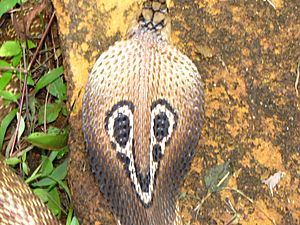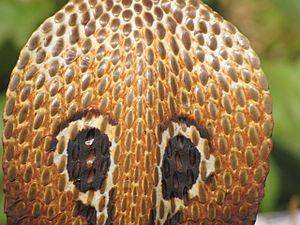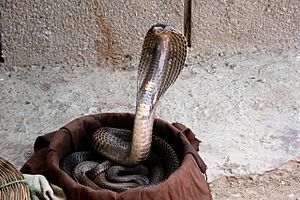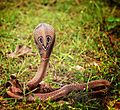Indian cobra facts for kids
Quick facts for kids Indian cobra |
|
|---|---|
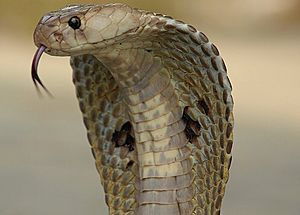 |
|
| Scientific classification | |
| Genus: |
Naja
|
| Species: |
naja
|
 |
|
| Indian cobra distribution | |
The Indian cobra (Naja naja) is a famous snake found in India and nearby countries. It's also known as the spectacled cobra or Asian cobra. This snake is one of the "big four" species that cause the most snakebites in India.
It's important to know that the Indian cobra is different from the king cobra. They belong to different groups of snakes. In Indian culture, the Indian cobra is highly respected and often seen with snake charmers. This snake is now protected in India by law.
Contents
About the Indian Cobra
The name Naja comes from the Sanskrit word nāgá, which means "cobra."
The Indian cobra is part of a group of snakes called Naja, which are all cobras. The first person to describe this specific type of cobra was Carl Linnaeus in 1758. The Indian cobra is seen as the classic cobra species among all the Asian cobras.
Local Names
Because the Indian cobra is common in South Asia, it has many different names in local languages. These names often come from the word Naga.
Here are some of them:
- Phetigom (ফেতিগোম) in Assamese
- Gokhra (গোখরো) in Bengali
- Naag (नाग) in Hindi
- Fetaar (फेटार) in Awadhi
- Naag (નાગ) in Gujarati
- Nagara Haavu (ನಾಗರ ಹಾವು) in Kannada
- Moorkan (മൂര്ഖന്) in Malayalam
- Gokhara Saapa (ଗୋଖର ସାପ) or Naaga Saapa (ନାଗ ସାପ) in Odia
- Naya (නයା) or Nagaya (නාගයා) in Sinhalese
- Nalla pambu (நல்ல பாம்பு) or Nagapambu (நாகப்பாம்பு) in Tamil
- నాగు పాము (Nagu Paamu) in Telugu
What the Indian Cobra Looks Like
The Indian cobra is a medium-sized snake with a strong body. You can easily spot it by its large and impressive hood, which it spreads out when it feels threatened.
Many Indian cobras have a special mark on the back of their hood. This mark looks like two circles connected by a curved line, similar to a pair of spectacles. That's why it's also called the "spectacled cobra."
The cobra's head is somewhat flat and slightly different from its neck. Its snout is short and round, and its eyes are medium-sized with round pupils. Most adult cobras are about 1 to 1.5 meters (3 to 5 feet) long. Some, especially in Sri Lanka, can grow up to 2.2 meters (7 feet), but this is rare.
The color and pattern of Indian cobras can vary a lot depending on where they live. Their underside can be grey, yellow, tan, brown, reddish, or black. Their top scales might have the hood mark or other patterns. Sometimes, especially in older snakes, you can see small speckles on their back.
Young cobras in some areas, like southern Pakistan, might be grey and may or may not have the hood mark. Adult cobras in these regions are often uniformly black on top, with a lighter underside.

Similar Snakes
Sometimes, people confuse the Indian cobra with other snakes. The Oriental rat snake (Ptyas mucosus) looks similar but is much longer and has a more ridged body. Other snakes that resemble the Indian cobra include the banded racer (Argyrogena fasciolata) and the Indian smooth snake (Coronella brachyura).
The monocled cobra (Naja kaouthia) can also be mistaken for the Indian cobra. However, the monocled cobra has an "O"-shaped pattern on its hood, while the Indian cobra has the "spectacles"-shaped pattern.
Where the Indian Cobra Lives
The Indian cobra lives in the Indian subcontinent. You can find it across India, Pakistan, Sri Lanka, Bangladesh, and southern Nepal. It usually doesn't live in very high mountains (above 2000 meters or 6,500 feet) or in extreme deserts.
This snake can live in many different places, like thick forests, open fields, farms (including rice fields), rocky areas, and even in towns and cities. It often stays near water. Indian cobras like to hide in holes in banks, hollow trees, termite mounds, piles of rocks, and small animal dens.
Reproduction
Indian cobras lay eggs. They usually lay their eggs between April and July. A female cobra typically lays 10 to 30 eggs in places like rat holes or termite mounds. The eggs hatch about 48 to 69 days later.
When they hatch, baby cobras are about 20 to 30 centimeters (8 to 12 inches) long. They are able to take care of themselves right away and already have working venom glands.
Venom
The Indian cobra's venom is very strong. It mainly contains substances that affect the nerves and the heart. The venom can paralyze muscles, which can lead to breathing problems or even cardiac arrest (when the heart stops). Symptoms of a bite can appear anywhere from 15 minutes to two hours after the bite.
Even though the Indian cobra causes many bites, most are not deadly if the person receives proper medical treatment and antivenom. The chance of dying from an untreated bite can be around 20–30%. However, with quick medical help, the death rate is much lower, sometimes as low as 9%.
The Indian cobra is one of the "big four" snakes in South Asia that are responsible for most snakebite deaths in the region. There is a special antivenom available that works against the venom of these snakes. Scientists are also working on new antivenoms.
Popular Culture
There are many stories and beliefs about cobras in India.
Hinduism
The Indian cobra is highly respected and sometimes feared in Hindu mythology. It is seen as a powerful deity. The Hindu god Shiva is often shown with a cobra named Vasuki coiled around his neck. This symbolizes his control over the world's illusions. Another god, Vishnu, is often shown resting on the giant snake deity Adishesha, who has many cobra heads. Cobras are also worshipped during Hindu festivals like Nag Panchami.
Snake Charming
The Indian cobra is famous because of snake charmers. When a snake charmer plays a flute, the cobra raises its head and spreads its hood, appearing to sway to the music. This makes for a unique show.
However, cobras are actually deaf to the flute's sound. They follow the movement of the charmer's pipe and can feel the ground vibrations from the charmer's tapping. For safety, sometimes the cobra's venom might be removed before the show. In the past, snake charmers also made cobras fight mongooses, but these fights are now against the law.
Heraldry
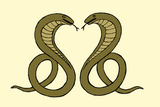
Indian cobras were often used in the official symbols of old princely states in India, like Gwalior and Kalahandi.
Gallery
-
Indian cobra outside a home in Yelandur, Karnataka, South India
Images for kids
See also
 In Spanish: Cobra de anteojos para niños
In Spanish: Cobra de anteojos para niños


